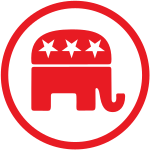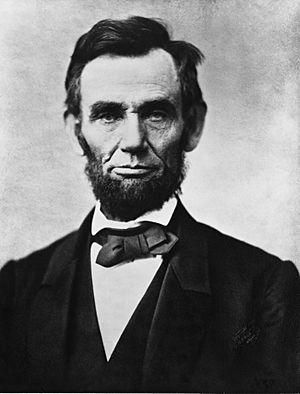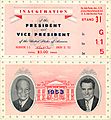History of the Republican Party (United States) facts for kids
Quick facts for kids
Republican Party
|
|
|---|---|
 |
|
| Other name | National Union Party |
| Founders | Amos Tuck Alvan E. Bovay |
| Founded | March 20, 1854 Ripon, Wisconsin, U.S. |
| Preceded by | Liberty Party Conscience Whigs Free Soil Party Anti-Nebraska movement North American Party |
| Headquarters | 310 First Street SE, Washington, D.C., 20003 |
| Membership | |
| Ideology |
• Fusionism
• Fiscal conservatism • Compassionate conservatism • Constitutional conservatism • Social conservatism • Neoconservatism • Paleoconservatism • Traditionalist conservatism • Right-libertarianism • Right-wing populism • Religious right |
| Colors | Red (since 2000) |
| Website | |
| gop.com | |
|
^ a: The GOP has been evaluated by political scientists as a conservative-liberal party. |
|
The Republican Party, also referred to as the GOP (meaning Grand Old Party), is one of the two major political parties in the United States. It is the second-oldest extant political party in the United States after its rival, the Democratic Party.
History
The American party system had been dominated by Whigs and Democrats for decades leading up to the Civil War. In 1854, the Kansas–Nebraska Act, passed by Democrats, opened Kansas Territory and Nebraska Territory to slavery and future admission as [[Slave and free states|s such as Zachariah Chandler and Free Soilers such as Salmon P. Chase.
The first anti-Nebraska local meeting where "Republican" was suggested as a name for a new anti-slavery party was held in a Ripon, Wisconsin schoolhouse on March 20, 1854. The first statewide convention that formed a platform and nominated candidates under the Republican name was held near Jackson, Michigan, on July 6, 1854. At that convention, the party opposed the expansion of slavery into new territories and selected a statewide slate of candidates.
The new Republican Party envisioned modernizing the United States, emphasizing expanded banking, more railroads, and factories, and giving free western land to farmers ("free soil") as opposed to letting slave owners buy up the best properties. It vigorously argued that free market labor was superior to slavery and was the very foundation of civic virtue and true republicanism; this was the "Free Soil, Free Labor, Free Men" ideology. Without using the term "containment", the Republican Party in the mid-1850s proposed a system of containing slavery.
The Republican Party launched its first national organizing convention in Pittsburgh, Pennsylvania on February 22, 1856. Its first national nominating convention was held in June 1856 in Philadelphia. John C. Frémont ran as the first Republican nominee for President in 1856 behind the slogan "Free soil, free silver, free men, Frémont and victory!" Although Frémont's bid was unsuccessful, the party showed a strong base. It dominated in New England, New York and the northern Midwest and had a strong presence in the rest of the North. It had almost no support in the South.
The early Republican Party consisted of northern Protestants, factory workers, professionals, businessmen, prosperous farmers, and after the Civil War, former black slaves. The party had very little support from white Southerners at the time, who predominantly backed the Democratic Party in the Solid South, and from Catholics, who made up a major Democratic voting block. The party opposed the expansion of slavery before 1861 and led the fight to destroy the Confederate States of America (1861–1865).
The election of Lincoln as president in 1860 opened a new era of Republican dominance based in the industrial North and agricultural Midwest. The Third Party System was dominated by the Republican Party (it lost the presidency only in 1884 and 1892). Lincoln proved brilliantly successful in uniting the factions of his party to fight for the Union in the Civil War. However, he usually fought the Radical Republicans who demanded harsher measures. Led by Senator William P. Fessenden and Congressman Thaddeus Stevens, Congress took the lead in economic policy, bringing in high tariffs, a new income tax, a national banking system, paper money ("Greenbacks") and enough taxes and loans to pay for the war.
Many conservative Democrats became War Democrats who had a deep belief in American nationalism and supported the war. When Lincoln added the abolition of slavery as a war goal, the Peace Democrats were energized and carried numerous state races, especially in Connecticut, Indiana and Illinois. Democrat Horatio Seymour was elected Governor of New York and immediately became a likely presidential candidate. Most of the state Republican parties accepted the antislavery goal except Kentucky.
During the Civil War, the party passed major legislation in Congress to promote rapid modernization, including a national banking system, high tariffs, the first temporary income tax (subsequently ruled constitutional in Springer v. United States), many excise taxes, paper money issued without backing ("greenbacks"), a huge national debt, homestead laws, railroads and aid to education and agriculture.
The Republicans denounced the peace-oriented Democrats as disloyal Copperheads and won enough War Democrats to maintain their majority in 1862. In 1864, they formed a coalition with many War Democrats as the National Union Party. Lincoln chose Democrat Andrew Johnson as his running mate and was easily re-elected.
The Republican Party largely dominated the national political scene until 1932.
In 1912, former Republican president Theodore Roosevelt formed the Progressive ("Bull Moose") Party after being rejected by the GOP and ran unsuccessfully as a third-party presidential candidate calling for social reforms. After 1912, many Roosevelt supporters left the Republican Party, and the Party underwent an ideological shift to the right. The GOP lost its congressional majorities during the Great Depression (1929–1940); under President Franklin D. Roosevelt, the Democrats formed a winning New Deal coalition that was dominant from 1932 through 1964.
After the Civil Rights Act of 1964, the Voting Rights Act of 1965 and the Southern Strategy, the party's core base shifted, with the Southern states becoming more reliably Republican in presidential politics and the Northeastern states becoming more reliably Democratic. White voters increasingly identified with the Republican Party after the 1960s.
The Republican Party won five of the six presidential elections from 1968 to 1988. Two-term President Ronald Reagan, who held office from 1981 to 1989, was a transformative party leader. His conservative policies called for reduced social government spending and regulation, increased military spending, lower taxes, and a strong anti-Soviet Union foreign policy. Reagan's influence upon the party persisted into the next century. Since the 1990s, the Party's support has chiefly come from the South, the Great Plains, the Mountain States, and rural areas in the North. Today, it supports free market economics, social conservatism, and originalism in constitutional jurisprudence. There have been 19 Republican presidents, the most from any one political party.
Images for kids
-
Birthplace of the Republican Party at a schoolhouse, in Ripon, Wisconsin
-
Musical Fund Hall at 808 Locust Street in Center City Philadelphia, where the first Republican nominating convention for president and vice president was held from June 17 to 19, 1856
-
African-American members of the United States Senate and the United States House of Representatives: Sen. Hiram Revels (R-MS) and Reps. Benjamin Turner (R-AL), Robert DeLarge (R-SC), Josiah Walls (R-FL), Jefferson Long (R-GA), Joseph Rainey and Robert B. Elliott (R-SC), 1872
-
Ulysses S. Grant was the first Republican president to serve for two full terms (1869–1877)
-
Theodore Roosevelt leads party to landslide win in 1904
-
Dwight D. Eisenhower and Richard Nixon, 1953: the first Republican presidential inauguration in 24 years
-
Ronald Reagan launched the "Reagan Revolution" with his election to the presidency in 1980, providing conservative influence that continues to the present day
-
Newt Gingrich, House Speaker (1995–1999), was the most visible adversary for President Bill Clinton
-
The presidency of George W. Bush was greatly impacted by the events of the September 11th terrorist attacks
-
John Boehner, House Speaker (2011–2015), was the most visible adversary for President Barack Obama
-
Donald Trump, 45th President of the United States














